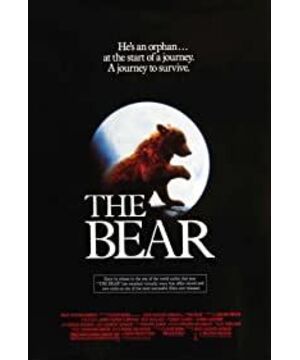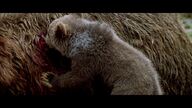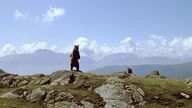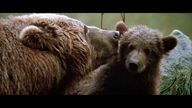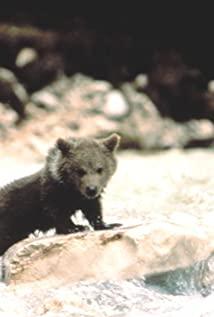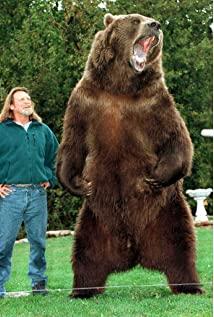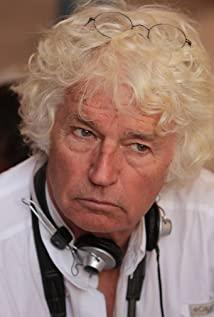"Bear's Tale" is a simple story about a bear who lost a loved one in an accident, a grizzly bear who was injured by a hunter and tried to fight back, and two capable and deeply rooted humility of nature. hunter. At first glance, I thought it was a nature documentary like "Microcosm". However, whether it is the interaction between bears, the confrontation between bears and hunters, or even the interaction between hunters and the natural environment of the virgin forest and mountainous area, they are all different. It is full of interlocking twists and turns and story elements.
The film begins with Yorkie the Bear and his father (or mother?) searching for and eating honey together, with a vibrant, wobbly close-up that brings the bear's world to life with the sound of bears smashing their mouths and bees humming to and fro. However, the big change came suddenly. The big bear was crushed to death by the rolling rocks, and the little bear was pulling desperately beside the big bear. When all attempts were ineffective, the background music sounded, and the melancholy melody filled with irrepressible sadness. There are no characters in this section, all the scenes are about two bears, but this is a relatively complete story, the language of the shots is changeable and just right, the mid-shot is fixed when it is soothing, and it is fast and swaying when it is in danger. A collection of elements.
The natural environment under the lens is also a vast expanse of green mountains and green valleys. In the large panorama that has appeared many times, the bears and hunters are placed in a natural environment, full of distant mountains and green valleys, while people or bears only occupy the extreme of the picture. A small corner is surprisingly small. The whole story is carried out in such an environment that relies on nature. Whether it is a man or a bear, or a hunter's horse or a hunting dog, they are all surrounded by mountains and rivers and jungles. Interaction is destined to be an interaction with nature, which may be the consistent attitude of "Bear's Tale" from the beginning: no matter what kind of plot occurs, it must be closely related to the natural occurrence in this jungle.
And indeed, whether it is the little bear York foraging or the hunter pulling the hound to hunt down the grizzly bear, or the simple or tortuous or thrilling story process is always placed in the big environment of the valley, and the intensity of the hunter chasing the grizzly bear is on the one hand. It enhances the grizzly bear's strong sense of revenge, and it also provides a sharp contrast to the play plot after capturing the cubs.
Another surreal factor outside of technology is also the distinctive performance of "Bear's Tale" in its narrative expression. The frogs that kept appearing when Little Bear was asleep jumped around in front of him, and the scene where the big bear was accidentally crushed to death flashed back in his dream, including the hallucination of the mushroom blossoming after Little Bear accidentally ingested poisonous mushrooms, all of which directly caused Little Bear The visual and psychological expression of "humanization", in "The Bear's Tale", does not simply oppose the bear and the human, but observes the bear as a living individual with the same status as the human. In the vast jungle, bears, like humans, are animals that are walking in pursuit of freedom. The difference is that hunters expect to achieve self-freedom by strangling the freedom of bears.
The hunter's killing was subversively reversed after getting along with the little bear York and the grizzly bear not killing it on the edge of the cliff. The two hunters failed to shoot and finally killed the grizzly bear, and initially entered as a role in destroying the harmonious ecology of the jungle. The hunter in the picture finally reached a double reconciliation of "man-bear" and "man-jungle nature", and became the relationship between man and bear in the plot where he seduced the tethered bear York with cheese and developed into a simple scrubbing. A milestone in breaking the ice, and the hunter who finally took the gun aimed at the grizzly but didn't fire, a silent subversion of the bullets that started the film with a close-up upside-down to the sky and the moon, meaning they no longer needed bullets to complete the jungle. trip. The jungle trip ended with the departure of the two hunters. They said goodbye to the bear cub who waved to them reluctantly, and also said goodbye to the unnatural invasion of this natural place. Since then, man and nature have regained their original harmony.
Although "The Bear's Tale" does not simply use the bear's story as a clue for narration and expression, the sub-bear York runs through the beginning and end of the whole film, and the process from repulsion to closeness between it and the grizzly is accompanied by hunters' pursuit and letting go Appears to be extremely precious. In the above-mentioned warm scene where Little Bear York and his relatives share honey with their relatives, the two bears lick their calves in a deep love on the screen, and this warm relationship becomes fragmented after the big bear is crushed to death. Little Bear dreamed back in the middle of the night, thinking of those fragments of coexistence with his relatives. This shortcoming was compensated for by the grizzly bear. At first, the grizzly bear was shot and injured by the hunter when they met. It was not at all close to the little bear. In the end, it was the grizzly bear's roar that drank York as a meal on the plate. The sturdy cheetah, at this time, the picture starts with York, whose mouth is full of blood, raising his head and howling, making people think that the roaring roar in his ears is actually from the mouth of the weak bear, and the camera pans to the right quickly, and gray in the background appears. Bear, the figures of the two bears have become an organic whole in the picture, indicating the beginning of a new deep emotion of licking. At the end of the film, the two bears are lying in a cave full of snow and wind, and Yorke snuggles up to the grizzly bear, and the final harmony between the bear and the bear is also achieved. The last scene becomes an organic continuation of the opening scene, with vitality and warmth flowing uninterruptedly in the river of their destiny.
The last thing worth mentioning is the director's control of the sound. Except for a few soundtracks, the whole film is almost a collection of natural sounds. Whether it is the sound of insects, wind, grass or sand, it restores the valley to the greatest extent. Original ecological look and feel. It can be said that the success of "Bear's Tale" is largely due to its delicate and real sound effects. This is also one of the reasons why this film has become a unique work in film history.
View more about The Bear reviews


